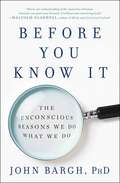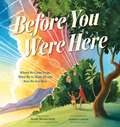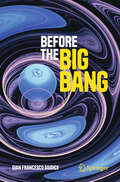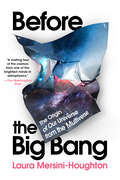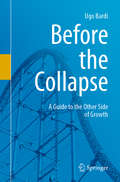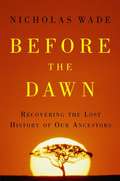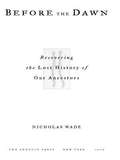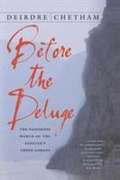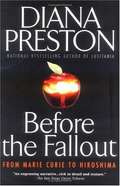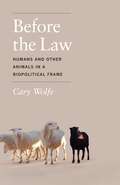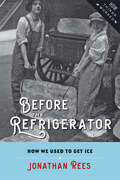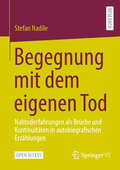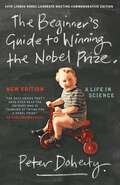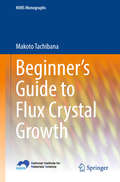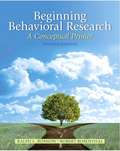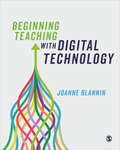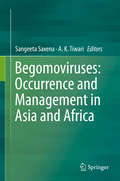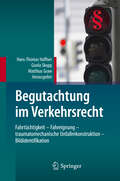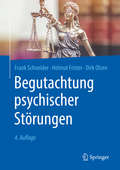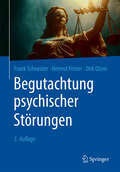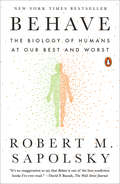- Table View
- List View
Before You Know It: The Unconscious Reasons We Do What We Do
by John BarghDr. John Bargh, the world’s leading expert on the unconscious mind, presents a groundbreaking book, twenty years in the making, which gives us an entirely new understanding of the hidden mental processes that secretly govern every aspect of our behavior.For more than three decades, Dr. John Bargh has been responsible for the revolutionary research into the unconscious mind, research that informed bestsellers like Blink and Thinking Fast and Slow. Now, in what Dr. John Gottman said “will be the most important and exciting book in psychology that has been written in the past twenty years,” Dr. Bargh takes us on an entertaining and enlightening tour of the forces that affect everyday behavior while transforming our understanding of ourselves in profound ways. Telling personal anecdotes with infectious enthusiasm and disclosing startling and delightful discoveries, Dr. Bargh takes the reader into his labs at New York University and Yale where he and his colleagues have discovered how the unconscious guides our behavior, goals, and motivations in areas like race relations, parenting, business, consumer behavior, and addiction. He reveals what science now knows about the pervasive influence of the unconscious mind in who we choose to date or vote for, what we buy, where we live, how we perform on tests and in job interviews, and much more. Because the unconscious works in ways we are completely unaware of, Before You Know It is full of surprising and entertaining revelations as well as tricks to help you remember to-do items, shop smarter, and sleep better. Destined to be a bestseller, Before You Know It is an intimate introduction to a fabulous world only recently discovered, the world that exists below the surface of your awareness and yet is the key to knowing yourself and unlocking new ways of thinking, feeling, and behaving.
Before You Were Here: Where We Come From, What We're Made Of, and How We Got Here
by Scott WesterfeldDive into a vibrant celebration of our connection to the natural world in this stunning picture book perfect for fans of Matt de la Peña and Loren Long's LOVE and Jason Chin's THE UNIVERSE IN YOU.Before you were here, you were everywhere...You were once the sunshine when it struck the trees. You were water, powerful enough to wear away mountains. You were soil deep beneath the earth.Now that you’re here, the world waits for you.Everywhere.Follow a young child as he explores the world around him and begins to understand that he is connected to all things -- sunshine which nourishes us, water which makes up most of our bodies, and soil which contains minerals that keep us strong and healthy.Blending a tale of new life with real science, this picture book by New York Times bestselling author of the Uglies series Scott Westerfeld and illustrated by Sibert Honor-winning Jessica Lanan is a sweeping ode to a parent's love for their child, budding life, and the Earth that we live on. *Includes robust backmatter that expands on the ways the natural world lives in our bodies.
Before the Big Bang (Copernicus Books)
by Gian Francesco GiudiceA theoretical physicist returns by train from a conference, his eyes fixed on a paper on quantum cosmology. Suddenly, a little girl's voice interrupts his musings. "What are you reading?" "It's the story of the universe." "If it tells the whole story of the universe, does it say anything about me?" Starting from this question, this book explores our current understanding of the Big Bang, the primordial event that gave rise to the special mixture of space, time, and matter that we call the universe. It is a journey through cosmic history, pushing the limits of human knowledge, winding its way through general relativity, curved spaces, quantum mechanics and the multiverse. Giudice succeeds in uniting science and the history of thought, tracing the debate that animated the physics community, when faced with the hypothesis and then the confirmation of the Big Bang. This book recounts the great discoveries in cosmology and leads us to the frontiers of current scientific research. It is a fascinating and thought-provoking parable that addresses complex concepts with the fluidity of storytelling and allows us to better understand the universe around us. “A fascinating, enchanting narrative. A fairy tale that tells a true story spanning 13.8 billion years. Exciting from the first to the last page.” Fabiola Gianotti, CERN Director General “In this beautiful book, of exemplary clarity, Giudice guides us by the hand through the history and mysteries of the Big Bang.” Giorgio Parisi, 2021 Nobel Prize in Physics
Before the Big Bang: The Origin of the Universe and What Lies Beyond
by Laura Mersini-HoughtonA revolutionary new account of our universe’s creation—and a breathtaking exploration of the landscape from which we sprang—from one of the world’s most celebrated cosmologistsWhat came before the Big Bang, and what exists outside of the universe it created? Until recently, scientists could only guess at what lay past the edge of space-time. However, as pioneering theoretical physicist Laura Mersini-Houghton explains, new scientific tools are now giving us the ability to peer beyond the limits of our universe and to test our theories about what is there. And what we are finding is upending everything we thought we knew about the cosmos and our place in it.Mersini-Houghton is no stranger to boundaries—or to pushing through them. As a child growing up in Communist Albania, she discovered a universe beyond her walled-off world through the study of math and science, and through music. As a female cosmologist in a male-dominated field, she transcended the limits that society and her profession tried to place on her. And as a trailblazing researcher, she helped to revolutionize the study of our universe by revealing that, far from living in a cosmic Albania, with a world that ends at its borders, we are part of a larger family of universes—a multiverse—that holds wonders we are only beginning to unlock. Mersini-Houghton’s groundbreaking research suggests that we sit in a quantum landscape whose peaks and valleys hide a multitude of other universes, and even hold the secret to the origins of existence itself. Recent evidence has revealed the signatures of such sibling universes in our own night sky, confirming Mersini-Houghton’s theoretical work and offering humbling evidence that our universe is just one member of an unending cosmic family.The incredible scientific saga of one woman’s mind-expanding journey through the multiverse, Before the Big Bang will reshape our understanding of humanity’s place in the unfathomable vastness of the cosmos.
Before the Big Bang: The Prehistory of Our Universe
by Brian CleggAccording to a recent survey, the most popular question about science from the general public was: what came before the Big Bang? We all know on some level what the Big Bang is, but we don't know how it became the accepted theory, or how we might know what came before. In Before the Big Bang, Brian Clegg (the critically acclaimed author of Upgrade Me and The God Effect) explores the history of this remarkable concept. From the earliest creation myths, through Hershel's realization that the Milky Way was one of many galaxies, to on-going debates about Black Holes, this is an incredible look at the origins of the universe and the many theories that led to the acceptance of the Big Bang. But in classic scientist fashion Clegg challenges the notion of the "Big Bang" itself, and raises the deep philosophical question of why we might want to rethink the origin of the universe. This is popular science at its best, exploratory, controversial, and utterly engrossing.
Before the Collapse: A Guide to the Other Side of Growth
by Ugo BardiNobody has to tell you that when things go bad, they go bad quickly and seemingly in bunches. Complicated structures like buildings or bridges are slow and laborious to build but, with a design flaw or enough explosive energy, take only seconds to collapse. This fate can befall a company, the stock market, or your house or town after a natural disaster, and the metaphor extends to economies, governments, and even whole societies. As we proceed blindly and incrementally in one direction or another, collapse often takes us by surprise. We step over what you will come to know as a “Seneca cliff”, which is named after the ancient Roman philosopher, Lucius Annaeus Seneca, who was the first to observe the ubiquitous truth that growth is slow but ruin is rapid. Modern science, like ancient philosophy, tell us that collapse is not a bug; it is a feature of the universe. Understanding this reality will help you to see and navigate the Seneca cliffs of life, or what Malcolm Gladwell called “tipping points.” Efforts to stave off collapse often mean that the cliff will be even steeper when you step over it. But the good news is that what looks to you like a collapse may be nothing more than the passage to a new condition that is better than the old.This book gives deeper meaning to familiar adages such as “it’s a house of cards”, “let nature take its course”, “reach a tipping point”, or the popular Silicon Valley expression, “fail fast, fail often.” As the old Roman philosopher noted, “nothing that exists today is not the result of a past collapse”, and this is the basis of what we call “The Seneca Strategy.” This engaging and insightful book will help you to use the Seneca Strategy to face failure and collapse at all scales, to understand why change may be inevitable, and to navigate the swirl of events that frequently threaten your balance and happiness. You will learn:How ancient philosophy and modern science agree that failure and collapse are normal features of the universePrinciples that help us manage, rather than be managed by, the biggest challenges of our lives and times Why technological progress may not prevent economic or societal collapseWhy the best strategy to oppose failure is not to resist at all costsHow you can “rebound” after collapse, to do better than before, and to avoid the same mistakes.
Before the Dawn: Recovering The Lost History of Our Ancestors
by Nicholas WadeWritten by a New York Times science reporter in language that is readable and comprehensible, for the most part, to the lay person, this book explains evolution in terms of genetics "The narrative of the human genome explains our origins, our history, and our nature...At its most basic, the process of evolution is simply a change in gene frequencies between generations; one version of a gene, in other words, becomes more common in a population and other versions less common..." there are quite a few symbols that are parts of names. All junk characters have been eliminated. All characters present that may appear to be junk are part of the book. The notes, bibliography and index have not been validated. I think they are comprehensible and usable; if you need them to be fixed, let me know and I will get the book and validate them. Cindy R popularplace@yahoo.com
Before the Dawn: Recovering the Lost History of Our Ancestors
by Nicholas WadeNicholas Wade's articles are a major reason why the science section has become the most popular, nationwide, in the New York Times. In his groundbreaking Before the Dawn, Wade reveals humanity's origins as never before-a journey made possible only recently by genetic science, whose incredible findings have answered such questions as: What was the first human language like? How large were the first societies, and how warlike were they? When did our ancestors first leave Africa, and by what route did they leave? By eloquently solving these and numerous other mysteries, Wade offers nothing less than a uniquely complete retelling of a story that began 500 centuries ago.
Before the Deluge: The Vanishing World of the Yangtze's Three Gorges
by Deirdre ChethamChetham's elegiac book about the towns along the banks of the Three Gorges area of the Yangtze River was written on the very eve of their destruction. After great controversy, the Chinese government has begun construction of the world's largest hydroelectric dam in the Three Gorges section of the Yangtze, a place renowned for its beauty. For over two thousand years, the Yangtze has been the great transport route linking the coast with the west and southwest and providing irrigation for thefarms that fed China. Once the dam is completed in 2009, the water level will rise as much as 350 feet in a hundred-mile stretch of the river. The water will submerge over a dozen large cities, almost 1,500 villages and towns, and innumerable historical and cultural sites. Over a million people are being moved, voluntarily or otherwise, altering not only their lives, but the lives of a multitude of others whose existence is intertwined with the river. Before the Deluge captures a sense of the daily life, traditions and history of the people who live along the Upper Yangtze's Three Gorges area. It chronicles the region's past and present with an eye on the disruption of an existing way of life. Perhaps most importantly, it captures a world that is rapidly vanishing under the rushing waters of one of the world's largest rivers.
Before the Fallout: From Marie Curie to Hiroshima
by Diana PrestonPreston describes the development of nuclear weapons, beginning with Marie Curie's work with radioactivity at the turn of the twentieth century and discussing the advances of subsequent scientists like Rutherford, Bohr, Einstein, and Oppenheimer. She traces how scientific discoveries were transformed into the atomic weapon first used on Hiroshima. Preston is the author of other books, including Lusitania: An Epic Tragedy.
Before the Law: Humans and other Animals in a Biopolitical Frame
by Cary WolfeAnimal studies and biopolitics are two of the most dynamic areas of interdisciplinary scholarship, but until now, they have had little to say to each other. Bringing these two emergent areas of thought into direct conversation in Before the Law, Cary Wolfe fosters a new discussion about the status of nonhuman animals and the shared plight of humans and animals under biopolitics. Wolfe argues that the human-animal distinction must be supplemented with the central distinction of biopolitics: the difference between those animals that are members of a community and those that are deemed killable but not murderable. From this understanding, we can begin to make sense of the fact that this distinction prevails within both the human and animal domains and address such difficult issues as why we afford some animals unprecedented levels of care and recognition while subjecting others to unparalleled forms of brutality and exploitation. Engaging with many major figures in biopolitical thought--from Heidegger, Arendt, and Foucault to Agamben, Esposito, and Derrida--Wolfe explores how biopolitics can help us understand both the ethical and political dimensions of the current questions surrounding the rights of animals.
Before the Refrigerator: How We Used to Get Ice (How Things Worked)
by Jonathan ReesHow increased access to ice—decades before refrigeration—transformed American life.During the late nineteenth and early twentieth centuries, Americans depended upon ice to stay cool and to keep their perishable foods fresh. Jonathan Rees tells the fascinating story of how people got ice before mechanical refrigeration came to the household. Drawing on newspapers, trade journals, and household advice books, Before the Refrigerator explains how Americans built a complex system to harvest, store, and transport ice to everyone who wanted it, even the very poor.Rees traces the evolution of the natural ice industry from its mechanization in the 1880s through its gradual collapse, which started after World War I. Meatpackers began experimenting with ice refrigeration to ship their products as early as the 1860s. Starting around 1890, large, bulky ice machines the size of small houses appeared on the scene, becoming an important source for the American ice supply. As ice machines shrunk, more people had access to better ice for a wide variety of purposes. By the early twentieth century, Rees writes, ice had become an essential tool for preserving perishable foods of all kinds, transforming what most people ate and drank every day. Reviewing all the inventions that made the ice industry possible and the way they worked together to prevent ice from melting, Rees demonstrates how technological systems can operate without a central controlling force. Before the Refrigerator is ideal for history of technology classes, food studies classes, or anyone interested in what daily life in the United States was like between 1880 and 1930.
Begegnung mit dem eigenen Tod: Nahtoderfahrungen als Brüche und Kontinuitäten in autobiografischen Erzählungen
by Stefan NadileIn diesem Open-Access-Buch wird die Nahtoderfahrung (NTE) als Phänomen im Kontext der Erforschung des Todes, daraus abgeleitete Todesdefinitionen und ihr Wandel vor dem Hintergrund historischer Entwicklungen und ihren gesellschaftlichen Trends beleuchtet. Mit dem Bekanntwerden des Phänomens können in Bezug auf die Aussagekraft von NTE verschiedene Deutungen identifiziert werden, die sich zum Teil mit dem Aufkommen neureligiöser Bewegungen institutionalisieren. Darauf folgt eine Hinwendung zu individuellen Innensichten auf die NTE und ihrer Kommunizierbarkeit. Die kommunikative Erörterung solcher Ereignisse gilt als Gegenstand der Darstellung eines außergewöhnlichen Ereignisses in der autobiografischen Erzählung. Die Argumentationslinie einerseits und die Topologie der Deutungsebenen andererseits bilden die Grundlage für die Analyse der Studienergebnisse. Als Datengrundlage dienen eigens für diese Arbeit erhobene biografisch-narrative Interviews. Deren Analyse resultiert in einer Typisierung, wie NTE im autobiografischen Kontext gedeutet werden, welche sozialen Deutungsmuster dabei implizit zum Tragen kommen und wie die Person von ihrer Biografie erzählt. Jeder Typus steht je für eine Grundhaltung zur Lebenswelt und je für eine Strategie zur Integration der Erfahrung in das eigene Leben.
Beginner's Guide to Winning the Nobel Prize: A Life in Science: New Edition
by Peter DohertyIs it possible to be passionate about politics, football or R&B and still be a creative scientist? In this entertaining and inspiring account, Nobel Prize winner Peter Doherty offers readers an insider's guide into discovery science and the individuals who work in it.Starting with the story of his own career and its improbable origins in the outer suburbs of Brisbane, and its progression to a breakthrough discovery about how human immunity works. Doherty explores the realities of a life in science. How research projects are selected; how discovery science is resourced and organised; the big problems it is trying to solve; and the rewards and pitfalls of a career in scientific research: all these are explored in The Beginner's Guide to Winning the Nobel Prize.Doherty gives readers an insight into the issues that make him tick including his belief that the mission of science is to help make the world a better place to live in. He also essays answers to some of the great questions of our age. Are Nobel Prize winners exceptional human beings or just lucky? Are GMO crops really dangerous? And why can't scientists and born-again Christians get along?
Beginner’s Guide to Flux Crystal Growth (NIMS Monographs)
by Makoto TachibanaThis book introduces the principles and techniques of crystal growth by the flux method, which is arguably the most useful way to obtain millimeter- to centimeter-sized single crystals for physical research. As it is possible to find an appropriate solvent ("flux") for nearly all inorganic materials, the flux method can be applied to the growth of many crystals ranging from transition metal oxides to intermetallic compounds. Both important principles and experimental procedures are described in a clear and accessible manner. Practical advice on various aspects of the experiment, which is not readily available in the literature, will assist the beginning graduate students in setting up the lab and conducting successful crystal growth. The mechanisms of crystal growth at an elementary level are also provided to better understand the techniques and to help in assessing the quality of the crystals. The book also contains many photographs of beautiful crystals with important physical properties of current interest, such as high-temperature superconductors, strongly correlated electronic systems, topological insulators, relaxor ferroelectrics, low-dimensional quantum magnets, non-linear optical materials, and multiferroics.
Beginning Behavioral Research: A Conceptual Primer
by Robert Rosenthal Ralph RosnowThis successful introduction to behavioral research methods-written by two leaders in the field-provides step-by-step guidance through the processes of planning an empirical study, analyzing and interpreting data, and reporting findings and conclusions. It encourages readers to be analytical and critical, not only in interpreting research findings, but also in investigating what is behind the claims and conclusions in news reports of scientific results. While the primary emphasis is on behavioral and social research, a strong effort is made to connect these disciplines with the empirical reasoning used in other fields in order to underscore the unity of science. The volume examines behavioral research and scientific method, creative ideas and working hypotheses, ethical considerations and guidelines, observation and measurement, design and implementation, describing data and making inferences, and statistical tests. For those interested in an introduction to research methods.
Beginning Teaching with Digital Technology
by Joanne BlanninTeachers are now expected to use technology to enhance students’ learning, but what does this mean in the classroom and how can you apply it effectively to subject teaching? This book, for pre-service and qualified teachers, offers you a guide for using technology in primary and secondary schools, including how to decide which technology resource to use, safeguarding and ethical considerations and computer coding in the classroom. Further guidance is provided on using technology across the learning areas of literacy, mathematics, STEM and the arts. Key features include: · Classroom scenarios which tackle common challenges faced by teachers and how to resolve them · Examples of best practice technology use in early childhood settings, primary and secondary classrooms · A future-proofed approach focusing on theory-informed best practice in an ever-changing world of devices and software Essential reading for pre-service teacher education students in both primary and secondary education courses on undergraduate and postgraduate routes into teaching and for qualified teachers looking to deepen their professional knowledge. Joanne Blannin is Senior Lecturer in Digital Transformations at Monash University.
Beginning Teaching with Digital Technology
by Joanne BlanninTeachers are now expected to use technology to enhance students’ learning, but what does this mean in the classroom and how can you apply it effectively to subject teaching? This book, for pre-service and qualified teachers, offers you a guide for using technology in primary and secondary schools, including how to decide which technology resource to use, safeguarding and ethical considerations and computer coding in the classroom. Further guidance is provided on using technology across the learning areas of literacy, mathematics, STEM and the arts. Key features include: · Classroom scenarios which tackle common challenges faced by teachers and how to resolve them · Examples of best practice technology use in early childhood settings, primary and secondary classrooms · A future-proofed approach focusing on theory-informed best practice in an ever-changing world of devices and software Essential reading for pre-service teacher education students in both primary and secondary education courses on undergraduate and postgraduate routes into teaching and for qualified teachers looking to deepen their professional knowledge. Joanne Blannin is Senior Lecturer in Digital Transformations at Monash University.
Beginnings: The Story of Origins - of Mankind, Life, the Earth, the Universe
by Isaac AsimovClarifying key scientific discoveries, Asimov takes us back through the millenia to the birth of the universe 15 billion years ago, then the first evidence of man and civilization.
Begomoviruses: Occurrence and Management in Asia and Africa
by Sangeeta Saxena A. K. TiwariBegomoviruses are one of the most interesting plant viruses to study for basic and applied research as they cause huge economic losses to agriculture industries and farmers all over the world. They belong to family Geminiviridae and are emergent plant viral pathogens which cause diseases in various crops in the tropical and subtropical regions. They are transmitted by the whitefly (B. tabaci) and have either one (monopartite DNA-A) or two (bipartite DNA-A and DNA-B) genomic components. DNA-A and DNA-B are of ~2600 - 2800 nucleotides each. A number of serious diseases of cultivated crops of the Fabaceae, Malvaceae, Solanaceae and Cucurbitaceae families are caused by Begomoviruses which are considered as threat to their cultivation in many countries. Accurate diagnosis is important for successful diseases management, since plants infected by Begomovirus do not recover, suffer serious yield losses and act as further sources of inoculum, which is then picked up and spread by their vector whitefly (B. tabaci). Reports of occurrence of new viruses and re-emergence of several known viruses in new niches have become regular event. In such a dynamic system, growth of several crop species relies on an accurate diagnosis, management and better understanding of the biology of the casual virus. This is crucial to evolve appropriate control practices and to prevent the virus infection. Researchers have achieved considerable progress in characterization, detection and management of virus on different crop species in the last decade. This book covers latest information in diagnosis of begomoviruses in the present scenario and explores the new vistas in the field of genomics and proteomics. Chapters in Section 1 illustrates the occurrence, genome organisation, transmission and diagnostics of begomoviruses. It also details the diseases caused by begomoviruses on different crops, detection techniques and management strategies in support of research findings by presentation of data, graphics, figures and tables. Section 2 is a chapterwise collection of occurrence, diversity and status of begomoviruses in Asian Africa counties where the diseases are most prevalent. This book will provide wide opportunity to the readers to have complete information and status of begomovirus in Asia and Africa. This will be useful resource for researchers and extension workers involved in the begomvirus disease diagnosis and molecular biology. Expert detection, accurate diagnosis and timely management play a significant role in keeping plants free from pathogens. In this book expert researchers share their research knowledge and literature which are vital towards the diagnosis of begomoviruses, addressing traditional plant pathology techniques as well as advance d molecular diagnostic approach. The book deals with the economically important crops including fruits, vegetables along with challenges in crop protection against diseases caused by begomovirus. This will be resourceful and handy for researcher, practitioners and also students.
Begutachtung im Verkehrsrecht: Fahrtüchtigkeit - Fahreignung - traumatomechanische Unfallrekonstruktion - Bildidentifikation
by Matthias Graw Gisela Skopp Hans-Thomas HaffnerDie Aufgabe des Gutachters im Gerichtsverfahren ist es, Juristen die Fachkenntnisse zu vermitteln, die für die Beurteilung eines Sachverhalts notwendig sind. Um diesen Vermittlungsprozess im Bereich der Verkehrsmedizin zu unterstützen, haben die Autoren das wissenschaftliche Basiswissen verständlich aufbereitet - von der forensischen Toxikologie über die biomechanische Unfallrekonstruktion bis zur anthropologischen Bildidentifikation. Sie zeigen die Möglichkeiten und Grenzen der Begutachtung auf und illustrieren dies anhand konkreter Fallbeispiele.
Begutachtung psychischer Störungen
by Frank Schneider Helmut Frister Dirk OlzenBegutachtungen von Menschen mit psychischen Störungen sind anspruchsvoll und gelten als schwierig. Das vorliegende Standardwerk bietet deshalb einen kompakten und gleichzeitig praxisnahen Leitfaden für ärztliche und psychologische Sachverständige, aber auch eine unverzichtbare und umfassende Grundlage für Juristen. Denn richtige und faire Entscheidungen der Gerichte können nur gefällt werden, wenn sich Mediziner, Psychologen und Juristen untereinander verständigen können. Dieses Buch leistet einen wesentlichen Beitrag zu diesem nicht immer einfachen, aber notwendigen und nicht zuletzt besonders interessanten und spannenden interdisziplinären Austausch. Das Werk zeichnet sich aus durch eine praxisbezogene, verständliche und klare Darstellung der wesentlichen Aspekte der psychiatrischen und psychologischen Begutachtung, ausführliche Beispielgutachten sowie zahlreiche Fallbeispiele aus der Praxis viele Tipps zum Erstellen eines Gutachtens die Darstellung des aktuellen Stands der medizinischen, psychologischen und juristischen Literatur, inklusive der neuesten Rechtsprechung und Gesetzgebung. Mit der nun vorliegenden vierten Auflage wurde das Werk zudem grundlegend aktualisiert. Das Buch ist ein wertvoller Begleiter für Mediziner, Psychologen, Juristen und alle anderen Interessierten, die mit psychiatrischen und psychologischen Gutachten zu tun haben.
Begutachtung psychischer Störungen
by Frank Schneider Helmut Frister Dirk OlzenBegutachtungen von Menschen mit psychischen Störungen sind anspruchsvoll und gelten als schwierig. Das vorliegende Standardwerk bietet deshalb einen kompakten und gleichzeitig praxisnahen Leitfaden für ärztliche und psychologische Sachverständige, aber auch eine unverzichtbare und umfassende Grundlage für Juristen. Denn richtige und faire Entscheidungen der Gerichte können nur gefällt werden, wenn sich Mediziner, Psychologen und Juristen untereinander verständigen können. Dieses Buch leistet einen wesentlichen Beitrag zu diesem nicht immer einfachen, aber notwendigen und nicht zuletzt besonders interessanten und spannenden interdisziplinären Austausch. Das Werk zeichnet sich aus durch eine praxisbezogene, verständliche und klare Darstellung der wesentlichen Aspekte der psychiatrischen und psychologischen Begutachtung, ausführliche Beispielgutachten sowie zahlreiche Fallbeispiele aus der Praxis viele Tipps zum Erstellen eines Gutachtens die Darstellung des aktuellen Stands der medizinischen, psychologischen und juristischen Literatur, inklusive der neuesten Rechtsprechung und Gesetzgebung. Das Buch ist ein wertvoller Begleiter für Mediziner, Psychologen, Juristen und alle anderen Interessierten, die mit psychiatrischen und psychologischen Gutachten zu tun haben. Mit der fünften Auflage wurde es erneut überarbeitet und aktualisiert. So wird beispielsweise bereits Bezug genommen auf die künftige ICD-11-Klassifikation, es werden aktuelle gesetzliche Änderungen, z.B. im Betreuungsrecht und bei der Behandlung von Kindern mit Varianten der Geschlechtsentwicklung (§ 1631e BGB), das neue 14. Buch des Sozialgesetzbuches, das neue Strafrechtsbezogene Unterbringungsgesetz NRW, die geänderten Voraussetzungen für die Unterbringung in einer Entziehungsanstalt (§ 64 StGB) sowie geänderte juristische Terminologien und aktuelle Literatur berücksichtigt.
Behandlungsfehler und Haftpflicht in der Viszeralchirurgie
by Hans-Peter Bruch Jörg Heberer Joachim Jähne Jürgen BauchDie Vermeidung von Behandlungsfehlern und der Umgang mit haftungsrechtlichen Konsequenzen ist für Chirurgen ein Thema von wachsender Bedeutung. In dem Band werden die rechtlichen Grundlagen, Verhaltensregeln und Verfahren der rechtlichen Klärung für die Viszeralchirurgie umfassend aufgearbeitet. Renommierte Kliniker beschreiben mögliche Behandlungsfehler, liefern Hinweise zur Fehlervermeidung und zeigen die rechtlichen Konsequenzen auf. Dabei werden sowohl konventionelle Operationsverfahren als auch die minimal invasive Chirurgie berücksichtigt.
Behave: The Biology of Humans at Our Best and Worst
by Robert M. SapolskyWhy do we do the things we do?Over a decade in the making, this game-changing book is Robert Sapolsky's genre-shattering attempt to answer that question as fully as perhaps only he could, looking at it from every angle. Sapolsky's storytelling concept is delightful but it also has a powerful intrinsic logic: he starts by looking at the factors that bear on a person's reaction in the precise moment a behavior occurs, and then hops back in time from there, in stages, ultimately ending up at the deep history of our species and its genetic inheritance.And so the first category of explanation is the neurobiological one. What goes on in a person's brain a second before the behavior happens? Then he pulls out to a slightly larger field of vision, a little earlier in time: What sight, sound, or smell triggers the nervous system to produce that behavior? And then, what hormones act hours to days earlier to change how responsive that individual is to the stimuli which trigger the nervous system? By now, he has increased our field of vision so that we are thinking about neurobiology and the sensory world of our environment and endocrinology in trying to explain what happened.Sapolsky keeps going--next to what features of the environment affected that person's brain, and then back to the childhood of the individual, and then to their genetic makeup. Finally, he expands the view to encompass factors larger than that one individual. How culture has shaped that individual's group, what ecological factors helped shape that culture, and on and on, back to evolutionary factors thousands and even millions of years old.The result is one of the most dazzling tours de horizon of the science of human behavior ever attempted, a majestic synthesis that harvests cutting-edge research across a range of disciplines to provide a subtle and nuanced perspective on why we ultimately do the things we do...for good and for ill. Sapolsky builds on this understanding to wrestle with some of our deepest and thorniest questions relating to tribalism and xenophobia, hierarchy and competition, morality and free will, and war and peace. Wise, humane, often very funny, Behave is a towering achievement, powerfully humanizing, and downright heroic in its own right.
